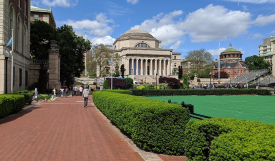Hurricane Melissa Jamaica Updates: Tourism Shutdowns and Economic Fallout Loom as Category 4 Storm Nears Landfall
Forecasters urge residents to prepare for prolonged, heavy rainfall

Hurricane Melissa has strengthened into a powerful Category 4 storm in the Caribbean Sea, with maximum sustained winds of around 140 miles per hour (225 kilometres per hour).
The National Hurricane Center (NHC) reports that the system is moving slowly westward at roughly 5 miles per hour, a sluggish pace that increases the risk of heavy and prolonged rainfall across Jamaica.
Meteorologists warn that Melissa could intensify further before making landfall on the island's southern coast, west of Kingston, late on Monday or early Tuesday.
The Jamaica Meteorological Service has issued a hurricane warning for the entire island, urging residents to take all necessary precautions. Authorities have described the storm as one of the most dangerous to threaten Jamaica in decades.
Tourism Shutdowns and Emergency Preparations
As Hurricane Melissa approaches, Jamaica's vital tourism industry has been brought to a halt. Norman Manley International Airport in Kingston and Sangster International Airport in Montego Bay were closed on Sunday, with dozens of inbound and outbound flights cancelled.
Cruise lines have suspended calls to Jamaican ports, and several coastal resorts have temporarily shut down operations, relocating guests to inland shelters.
Prime Minister Andrew Holness has activated the country's national disaster response plan, opening hundreds of emergency shelters and mobilising disaster relief teams.
Residents in low-lying areas have been urged to evacuate, particularly along the southern coastline, where storm surges of up to 13 feet are possible.
Evan Thompson, Director of the Meteorological Service of Jamaica, said the storm posed a serious threat to the island, warning that its slow movement and intense rainfall could make it more dangerous than previous hurricanes. He urged residents to prepare immediately and take official advisories seriously.
Tourism accounts for nearly 30 per cent of Jamaica's gross domestic product, and the suspension of flights, hotel closures and cancelled cruises are expected to cause millions in lost revenue.
Economic Fallout and Infrastructure Concerns
Economists and government officials are warning that Hurricane Melissa could inflict widespread economic damage if its slow-moving core lingers over the island. Aside from the tourism shutdown, there are fears of destruction to agriculture, transport networks and power infrastructure.
Prolonged rainfall could trigger landslides in mountainous regions and flooding in urban centres such as Kingston, Spanish Town and Mandeville.
According to NPR, both Norman Manley International Airport near Kingston and Sangster International Airport in Montego Bay were closed on Sunday ahead of the storm, as authorities prepared for potential flooding and infrastructure damage.
The National Works Agency has pre-positioned equipment to clear blocked roads and restore access to key highways once conditions allow.
Comparisons are already being made to Hurricane Gilbert in 1988, which devastated Jamaica's infrastructure and economy. While modern preparedness has improved significantly since then, officials remain cautious about Melissa's potential to cause extensive disruption.
Regional Impact Across the Caribbean
Melissa's effects are already being felt beyond Jamaica. Parts of southern Haiti and the Dominican Republic have reported torrential rain, flash flooding and landslides, with at least four fatalities confirmed over the weekend.
Coastal areas across eastern Cuba are also under alert as the storm's outer bands approach.
Meteorologists forecast up to 30 to 40 inches (760 to 1,000 millimetres) of rainfall in some areas of Jamaica, heightening the risk of flash flooding and river overflows.
Storm surges and powerful waves are expected to batter the southern coastline, particularly in Clarendon, Manchester and St Elizabeth parishes.
Climate and Seasonal Context
The 2025 Atlantic hurricane season has been unusually active, marked by several rapidly intensifying storms.
Hurricane Melissa's swift escalation from a tropical storm to a Category 4 hurricane within 48 hours highlights a growing pattern linked to warming sea-surface temperatures in the Caribbean.
Climate scientists warn that such rapid intensification events are becoming more common as ocean temperatures rise, providing storms with the energy to strengthen quickly before landfall.
Melissa now stands as one of the most potent hurricanes to threaten Jamaica in nearly forty years, underscoring the island's increasing vulnerability to severe weather in a changing climate.
Originally published on IBTimes UK
Subscribe to Latin Post!
Sign up for our free newsletter for the Latest coverage!
© Copyright IBTimes 2025. All rights reserved.















